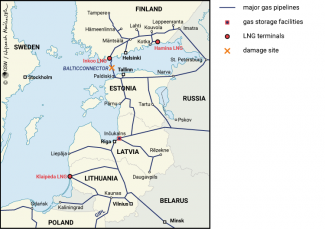The Balticconnector gas pipeline damage
On 8 October, the gas transmission operators (Finland’s Gasgrid and Estonia’s Elering) noticed a drop in pressure in the Balticconnector bi-directional undersea gas pipeline, which connects the gas systems of Finland and Estonia through the Gulf of Finland. The interconnector between Inkoo, Finland and Paldiski, Estonia is 150 km long, and a 77 km section of it runs on the seabed. It was decided to shut down the interconnector due to the suspicion that the pipeline might be damaged and gas might be leaking. When the fault occurred, gas was being sent from Finland to Estonia and from there to customers in Latvia. Initial data collected by operators suggested that the damage had been caused by external interference. It was also revealed that the telecom cable running along the Balticconnector had also been damaged.
On 10 October, Finland’s President Sauli Niinistö said that the gas pipeline had been damaged due to external actions, which was confirmed by Prime Minister Petteri Orpo on the same day. The sabotage option became the main thread in the investigation conducted by the Finnish Central Criminal Police. This hypothesis gained strength when Finland’s agencies located the damage on 10 October. Analysis of the photos confirmed that the cause was mechanical damage caused by people. Finland and Estonia are cooperating closely on the investigation and the plans to repair the interconnector. NATO has also promised to support them in the course of the investigation. In addition to this, Sweden has promised to help with repairs, which will last until April 2024.
Balticconnector was launched in 2020 and enables gas trade between the Baltic states and Finland. It was responsible for Finland joining the GET Baltic exchange, which is the operator of natural gas trading on the Lithuanian, Latvian and Estonian markets. The interconnector contributes greatly to strengthening the energy security in all these four countries. It is the only gas pipeline capable of supplying natural gas to Finland which bypasses Russia. The pipeline gained importance in May 2022, when Russia cut gas supplies to Finland after the Finnish government refused to pay for gas in roubles. The Baltic states had stopped buying gas from Russia after it invaded Ukraine.
Commentary
- The investigation and repair of the gas pipeline will be complicated due to the location of the damage which is in an area with heavy ship traffic. The main investigation is being conducted by Finland, as the leak site was located in its exclusive economic zone. Investigators have ruled out the scenario that it was caused by one of the ships (at least those that had transmitters turned on) passing over the gas pipeline, which is laid at a depth of 60–70 m.
- New information linked to the damage to the gas pipeline continues to appear, but it has not yet been confirmed by the Finnish and Estonian authorities. The Marine Traffic Agency, which monitors ship traffic around the world, determined that the Russian cargo vessel SVG Flot was anchored near the place where the leak occurred throughout the weekend. Neither Finnish nor Estonian seismologists recorded the explosion in the Gulf of Finland that was reportedly detected by the Norwegian foundation NORSAR (which is focused on researching earthquakes and volcanic eruptions). NORSAR suggested that the damage could have been caused when the ship’s anchor hit the Balticconnector or as a result of a small explosion. It is suspected that the place where the telecom cable is damaged is located within the boundaries of the Estonian exclusive economic zone (the precise location will be determined by the Estonian navy), therefore Tallinn will launch its own investigation. The cable break did not cause an interruption of telecommunications services, as it was only a backup connection.
- The damage has not affected the security of gas supplies in Lithuania, Latvia and Estonia. All these countries use a reserve underground gas tank in Inčukalns, Latvia. This season it is filled almost to the maximum (21.5 TWh), so it can satisfy the demand for gas in the Baltic states for up to a year. Gas can also be supplied to the region through the LNG terminal in Klaipėda and through GIPL, a gas connector with Poland. Finland, in turn, can import gas through its Inkoo and Hamina LNG terminals in the Gulf of Finland. The shutdown of Balticconnector has already resulted in a slight increase in gas prices in this country. The prices may rise even further, unless the interconnector is brought back to operation soon, and Helsinki will be forced to import gas through its terminals for a longer period of time. No price rises are expected in the Baltic region; the demand there will continue to be satisfied mainly with the gas stored in Inčukalns.
- The damage to the Finnish-Estonian gas interconnector has forced the Baltic states to take further measures to improve the protection of critical infrastructure. Lithuania, which has a key regional LNG terminal in Klaipėda and the NordBalt HVDC power cable running to Sweden, is currently working on further improving the security of its energy facilities. They are protected by anti-drone systems, and critical infrastructure elements are concealed under special constructions. Equipment reserves are also being restocked to enable repairs to be made in the event of damage. Additional security measures for the underwater section are being installed at the LNG terminal in Klaipėda.
- Finland views the Balticconnector damage as a serious incident, the first of this kind since the country joined NATO. At its request, the situation is to be discussed at the meeting of NATO defence ministers on 11 October. Finland’s government decided to deploy navy ships in the region of the gas pipeline, although Prime Minister Orpo stated that there was no need to increase the level of readiness of the armed forces. Helsinki is refraining from official speculations about the cause or perpetrator of the damage, waiting for the results of the investigation. There is an emphasis in public discussions in Finland that an act of sabotage would not be a surprise, and Russia has been indicated as a suspect. Finnish politicians and experts have warned against Russian hybrid actions in recent months. Actions of this type are intended to put pressure on Helsinki to self-restrict the NATO presence in Finnish territory. Both the initial stage of the investigation into the damage of the interconnector and the fact that it is being conducted by the Finnish authorities prevent Estonians from promoting their own interpretation of the incident.
Map. Gas systems in the Baltic region

Source: developed by the author on the basis of gasgrid.fi.





